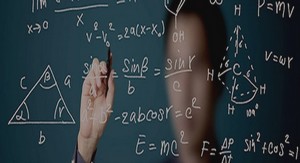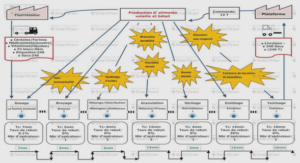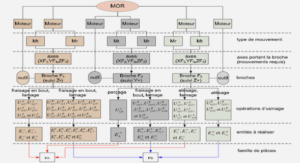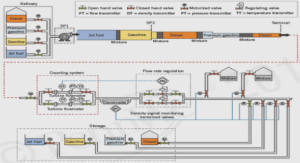A relaxation method for two-phase flow models with hydrodynamic closure law
Abstract The present paper is devoted to the numerical approximation of the solutions of a system of conservation laws arising in the modeling of two-phase flows in oil and gas pipeline. The PDEs are closed by two (generally speaking) highly nonlinear algebraic relations : namely a pressure law and a hydrodynamic one. The severe nonlinearities they encode make the classical approximate Riemann solvers to be virtually intractable at a reasonable cost of evaluation. We propose an original strategy for relaxing solely these two nonlinearities : the relaxation system we introduce is nonlinear and is analyzed on the ground of a Chapman-Enskog like expansion. Our model is of course hyperbolic but all the associated fields are linearly degenerate. Such a property not only makes trivial the resolution of the Riemann problem but also unables us to enforce for validity several stability requirements. The new method turns out to be fairly simple and robust while achieving desirable positivity properties on the density and mass fractions. Numerical evidences are proposed. Key words Two-phase flows, finite volume schemes, relaxation Introduction The petroleum pipelines drive a mixing, made up essentially of oil, gas and water, over a long distance. Locally, variations in the topography strongly influence the nature of the mixing : stratified, emulsion, slug for instance (see [26], [50] and the references therein). Several models must be then considered, each of them corresponding to a specific flow regime. All of the models we shall be considering are characterized by the choice of two algebraic closures : the first one defines the pressure of a mixing gas-liquid as a function of its composition ; the second one prescribes the hydrodynamic law, e.g., the velocity difference between the two phases of the flow as a function of the unknowns, such a function being defined according to the local incline of the pipeline. The model considered in this paper describes a two-phase flow inside a pipeline with a uniform section but for general pressure and hydrodynamic laws. The main interest of dealing with such a model is to focuse attention on the difficulties associated with the hydrodynamic law, which besides the pressure law, gives rise to the main nonlinearities in the model. In the flow, the gas (resp. liquid) is characterized by its density ρG (resp. ρL), its velocity vG (resp. vL) and its surface fraction RG ∈ [0, 1] (resp. RL ∈ [0, 1]) with the property RL + RG = 1.These formulae clearly highlight that the flux function is in full generality highly nonlinear! Besides this observation, such nonlinearities are obviously responsible for the basic mathematical properties of the model. For instance, considering the simplest framework : namely a pressure law satisfying the assumption w1 ∂p ∂w1 + w2 ∂p ∂w2 > 0 together with a no-slip hydrodynamic law, i.e., Φ ≡ 0, then the system (3.1) can be shown to be hyperbolic (see for instance Benzoni-Gavage [11]). However, as soon as Φ 6≡ 0, the system (3.1) is generally only conditionally hyperbolic : indeed for |vL −vG| = |Φ| large enough the hyperbolicity property is lost. To cap it all, arbitrary hydrodynamic closure (3.2) precludes the existence of additional non trivial conservation law for smooth solution of (3.1)–(3.2). In other words and without restrictive physical assumptions (like Φ = 0), the system under consideration cannot be endowed with an entropy pair. Turning considering the issue of approximating the solutions of (3.1)-(3.2), let us stress out that the algebraic complexity due to the above mentionned nonlinearities prevents us from using classical approximate Riemann solvers, whenever a low cost of computational effort is a critical issue. Let us simply recall that the latters strongly make use of the eigen-structure of the exact Jacobian matrix (see [30], [33], [35], [56] . . .). Notice that even for simpler methods, like the well-known Lax-Friedrichs scheme (see Godlewski-Raviart [33]), one needs an estimate of the largest eigenvalue of the Jacobian matrix. In the present work, we propose a strategy of relaxation of the two main nonlinearities involved in (3.1)-(3.2). Since no entropy pair is known for the system under consideration, our approach cannot enter the general relaxation theory developped by Liu [47], Chen et al. [16]. We are thus led to adopt the framework proposed by Whitham [64] which relies on suitable ChapmanEnskog expansions. As expected, such expansions will provide us with some sub-characteristic like conditions expressing that some diffusion matrix must stay non-negative (see also [16] and [47] ). The scheme we propose below differs from the classical relaxation scheme developed by Jin and Xin [69] (recently studied by Natalini [52], Aregba and Natalini [3] in the scalar cases) since not al
A relaxation model
In order to conveniently relax the main nonlinearities involved in the system under consideration, namely both the pressure law and the hydrodynamic one ; we first perform a conservative change of variables which thus preserves the weak solutions of (3.1)–(3.2). In that aim, let us consider the total density of the mixing ρ = ρLRL +ρGRG, the total momentum ρv = ρLRLvL +ρGRGvG and ρY where Y denotes the mass fraction of one of the two phases.
Design of the relaxation system
We propose to rewrite the system (3.5) in terms of the Lagrangian coordinates based on the density ρ and the velocity v. Let us set τ = 1/ρ, and define the Lagrangian mass coordinate y setting dy = ρdx − ρvdt. Then the equilibrium system in Lagrangian coordinates (see for instance Serre [59] or Godlewski and Raviart [33]) writes
In (3.10), a and b denote two real free parameters in the relaxation procedure we propose. All along the present work, we shall pay a central attention to the specification of these two constants, on the ground of several stability requirements. With this respect, successive and sharper definitions for such a pair will be given in the forthcoming sections. The final definition of (a, b) is postponed to Section 3.2.4. It is however useful to shed some light, from now on, on the significance of the pair (a, b). The proof of this easy result is left to the reader. Let us observe that the Lagrangian form (3.9) of our relaxation model is nothing else a first order quasi-linear system with singular perturbations. With this respect, the relaxation procedure we propose now finds clear relationships with the Xin and Jin approach [69] but at the expense of a Lagrangian transformation. To go further, let us set the relaxation parameter λ to zero. Then, the system (3.9) splits itself into two independent linear hyperbolic systems, one in the unknowns (τ, v, Π), the other in (Y, Σ). The first group of unknowns can be associated respectively with the specific volume, the velocity and the pressure of an hypothetic gas where the parameter a would play the role of a (constant) Lagrangian sound speed. Likewise, the second pair would characterize the specific volume Y and the velocity Σ of a hypothetic isentropic gas with the parameter b as sound speed. These two (linear) hypothetic gas dynamics systems have connections with the recent works by Bouchut [13], Despr´es [22] and Suliciu [60] ; all these works being primarily devoted to the Lagrangian setting. Our approach, already introduced in other contexts (see [20] and [19]), could be thus understood as an extension to the Eulerian framework. Let us now state the basic properties of the Eulerian form (3.10).
Lemma 3.1.3
Let (a, b) be a pair of strictly positive real numbers For any v ∈ V, the first order system extracted from (3.10) admits five real eigenvalues (τ = 1/ρ) v, v±aτ, v±bτ, and five linearly independent corresponding eigenvectors. Consequently, the first order extracted system from (3.10) is hyperbolic on V. Moreover, each eigenvalue is associated with a linearly degenerate field. Linear degeneracy of each of the fields is a by-product of the derivation principle of the nonlinear relaxation model (3.10). Such a property is expected from the Lagrangian form (3.9) (see indeed Wagner [63]). It is actually desired since it makes straightforwardly solvable the Riemann problem associated with (3.10) when λ = 0 (see indeed Proposition 3.2.2, Section 3.2.1). Proof The hyperbolicity properties of a first order nonlinear system are known to be independent from a given change of variables (see Godlewski and Raviart [33] for instance). It is then convenient to use the non conservation form (3.11) to immediately derive the required eigenvalues. Easy calculations show that the following vectors ri(v), i = 1, . . . , 5, given by : (1, 0, 0, 0, 0), (ρ, ±aτ, a 2 τ, 0, 0) and (0, 0, 0, 1, ∓b), (3.14) are respectively right eigenvectors for the eigenvalues λi(v) : v, v ± aτ , and v ± bτ . These vectors are clearly independent provided that the parameters a and b are not zero. It is easily seen that ∇λi(v)· ri(v) = 0 for i = 1, . . . , 5 for all v ∈ V. Such a property expresses, after Lax [43], the linear degeneracy of all the fields under consideration.





